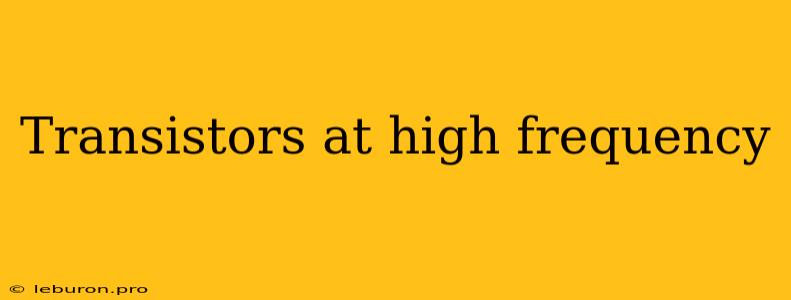The Challenges and Opportunities of Transistors at High Frequencies
The rapid evolution of modern electronics is driven by the relentless pursuit of higher frequencies. This demand arises from the ever-increasing need for faster data processing, communication, and signal processing capabilities. At the heart of this advancement lies the transistor, a fundamental building block of all electronic circuits. While transistors have been remarkably successful in achieving high-frequency operation, several challenges emerge as we push them to their limits. This article delves into the intricate world of transistors at high frequencies, exploring the limitations they face and the innovative solutions being developed to overcome them.
Understanding the Limitations of Transistors at High Frequencies
Transistors, by their very nature, are not perfect switches. They exhibit inherent limitations, which become more pronounced as the operating frequency increases. These limitations can be broadly categorized into three key areas:
1. Parasitic Capacitances and Inductances
Every transistor, regardless of its size or construction, possesses parasitic elements – unwanted capacitances and inductances that arise from the physical structure of the device. These parasitic elements become significant at high frequencies, affecting the transistor's performance in several ways:
- Reduced Gain: Parasitic capacitances shunt the input signal, reducing the gain of the transistor. This is particularly detrimental in amplifiers, where high gain is essential.
- Increased Power Consumption: Parasitic inductances cause current to flow through unintended paths, leading to increased power dissipation and inefficiency.
- Signal Distortion: The combination of parasitic capacitances and inductances can cause signal distortion, introducing unwanted harmonics and reducing signal fidelity.
2. Transit Time Effects
The speed at which electrons or holes travel across the transistor's active region, known as the transit time, becomes a critical factor at high frequencies. As the frequency increases, the transit time becomes a non-negligible portion of the signal period. This leads to:
- Phase Shift: Signal propagation through the transistor introduces a phase shift, which can cause instability in high-frequency circuits.
- Reduced Bandwidth: The transit time limits the bandwidth of the transistor, restricting the range of frequencies it can effectively amplify or switch.
3. Interconnect Effects
At high frequencies, interconnects – the wires connecting different components on the chip – can no longer be treated as ideal conductors. They exhibit parasitic capacitances and inductances, similar to the transistor itself. These effects lead to:
- Signal Attenuation: The resistance and inductance of interconnects cause signal attenuation, weakening the signal as it travels from one component to another.
- Signal Reflections: Interconnect capacitances can cause signal reflections, distorting the signal and introducing unwanted noise.
Overcoming the Challenges: Innovative Solutions for High-Frequency Transistors
Despite the challenges, continuous research and development have led to a variety of innovative solutions aimed at improving transistor performance at high frequencies:
1. Scaling Down Transistor Dimensions
One of the most effective strategies for mitigating parasitic capacitances and inductances is to reduce the physical size of the transistor. This approach, known as scaling, has been a cornerstone of the semiconductor industry's progress for decades. Smaller transistors exhibit lower parasitic elements, enabling higher operating frequencies.
2. Advanced Materials and Fabrication Techniques
Utilizing advanced materials and fabrication techniques is crucial for enhancing transistor performance. For example, using low-k dielectric materials between layers of the transistor can reduce parasitic capacitances. Similarly, employing novel materials with higher electron mobility can improve the transit time and reduce the overall operating frequency limitations.
3. Heterojunctions and Quantum Well Transistors
Heterojunctions, which combine different semiconductor materials with distinct properties, offer a promising approach to improving transistor performance. By strategically engineering these junctions, it's possible to create devices with higher electron mobility and lower parasitic elements. Quantum well transistors, utilizing the principles of quantum mechanics, further enhance electron transport and improve the high-frequency capabilities.
4. Low-Power Design Techniques
Reducing power consumption is crucial for extending battery life and minimizing heat generation in high-frequency circuits. Power-efficient design techniques, such as using low-voltage supply rails and optimizing circuit architectures, can significantly improve the overall performance and efficiency of high-frequency systems.
5. System-Level Optimization
High-frequency performance depends not only on individual transistors but also on the design of the entire system. System-level optimization strategies, such as using impedance matching techniques to minimize signal reflections and employing efficient routing schemes to reduce interconnect losses, are essential for achieving optimal performance at high frequencies.
The Future of Transistors at High Frequencies
The quest for higher frequencies in electronics is a continuous journey. While challenges remain, the relentless pursuit of innovation is leading to remarkable breakthroughs. Transistors are constantly evolving, and their ability to operate at increasingly higher frequencies will continue to shape the future of electronics. From faster computers and mobile devices to advanced communication systems and cutting-edge scientific instruments, the development of high-frequency transistors will continue to drive the progress of technology for years to come. As researchers continue to push the boundaries of transistor technology, we can expect even more dramatic improvements in performance and efficiency, unlocking new possibilities in the world of electronics. The advancements in transistors at high frequencies will be critical for enabling the next generation of devices and systems that will transform our world.
